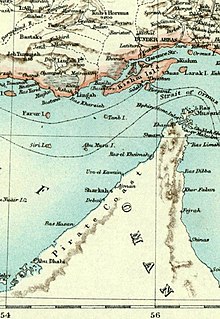This article includes a list of general references, but it lacks sufficient corresponding inline citations. Please help to improve this article by introducing more precise citations. (February 2022) (Learn how and when to remove this message)
|
Hormuz Island (/hɔːrˈmuːz/; Persian: جزیره هرمز, romanized: Jazireh-ye Hormoz), also spelled Ormus, is an Iranian island in the Persian Gulf. Located in the Strait of Hormuz, 8 km (5 mi) off the Iranian coast, the island is part of Hormozgan Province. It is sparsely inhabited, but some development has taken place since the late 20th century.
Hormuz Island
| |
|---|---|
Island
| |

Satellite photo of Hormuz Island
| |
 | |
|
| |
| Coordinates: 27°04′03″N 56°27′36″E / 27.06750°N 56.46000°E / 27.06750; 56.46000 | |
| Country | |
| Province | Hormozgān |
| Area | |
| • Land | 42 km2 (16.2 sq mi) |
| Elevation | 186 m (610 ft) |
| Time zone | UTC+3:30 (IRST) |


The earliest evidence for human presence on the island is several stone artifacts discovered at the eastern shorelines of the island. A lithic scatter was found at a site called Chand-Derakht, which is an uplifted marine Pleistocene terrace. This site yielded a Middle Paleolithic lithic assemblage characterized by Levallois methods and dates back to more than 40,000 years ago.[1]
The island, known as Organa (Όργανα) to the ancient Greeks and as Jarun in the Islamic period, acquired the name of "Hormuz" from the important harbour town of Hormuz (Ormus) on the mainland 60 km away, which had been a centre of a minor principality on both sides of the strait. The principality paid tribute to the Mongol-ruled Ilkhanate and was an important source of income from maritime trade.[2] The town's ruler decided to shift his residence to the island around 1300, in order to evade attacks by Mongolian and Turkish groups from the interior.[3] The ruler later made peace with the Ilkhans.
Ibn Battuta also visited the island and New Hormuz.[4]
In 1505, King Manuel I of Portugal established a policy of expansion in Africa and Western Asia. During attempts to expand Portuguese influence into the Indian Ocean, the Portuguese duke Afonso de Albuquerque captured the island in 1507 and it was incorporated into the greater Portuguese Empire. The Portuguese constructed a fortress on the island to deter potential invaders, naming it the Fort of Our Lady of the Conception. The island became an emergency stopover point for Portuguese ships traveling to Goa, Gujarat, and nearby Kishm. The Ottomans laid siege to the island under the admiral and cartographer Piri Reis in 1552.[5]
Shah Abbas I of Persia distrusted the local population and was not interested in maintaining the island as a trading centre or military post; instead he developed the nearby mainland port of Bandar Abbas. Hormuz went into decline. Many of its inhabitants seasonally moved to their fields and orchards around the old Hormuz on the mainland, only fishermen being in permanent residence. The island continued to export small quantities of rock salt and lumps of iron oxide which were used as ballast stones for sailing ships.[6]
Hormuz Island has an area of 42 km2 (16 sq mi).[citation needed]
Reddish ochre on the island and its beaches, called Golak by natives, has been exploited for artistic and culinary purposes, and also attracts tourists. Degradation due to overuse of the ochre has resulted in actions by the Department of Environment to protect it.[7]
The satellite images catching the concentric arrangement of the rocks show that Hormuz Island appears to be a so called salt diapir, composed of ancient seasalt deposists which due to lack of salt dissolving groundwater and rains and due to their plastic deformabilty can flow and squeeze just like ice and thus under the squeezing pressure of other sediments on top has managed to rise above the surface over many many thousands of years, and during that time has been eroded into different shapes. The geological age of the Hormuz island is about 600 million years, and its life out of the water is about 50 thousand years.[8]
The mountain being on the shoreline, makes the red beach and red sea waves an unusual sight. Visitors walking along the shore will encounter areas where sand glitters with metal compounds.[9]
Hormuz island has a forest of mangrove trees. The waterways and wild birds with its pristine nature attracts many tourists. Sea Forest has trees that live in the saltwater tidal area. Sometime most of them submerge in the sea water, but continue to survive. Iran’s southern coast is known for its aridity and salty sea water. there is a grassy area, that grows without the need for fresh water. In a story this mythical plant is grown from Adam’s tears.[10]
The Museum of Dr Nadalian in Hormuz Island, also known as the Museum and Gallery of Ahmad Nadalian in Hormuz Island, shows the work of Ahmad Nadalian (born 1963[11]), whose works have been shown in galleries internationally.[12] His environmental art projects include rock carvings, and not only his work, but also that of local indigenous women, bones of sea creatures are displayed in his museum,[13] and dolls made of recycled materials.[14]
The museum was created in March 2009 as the Paradise Art Centre, being renamed in 2012 to its current name. Also at this time, its entrance was redesigned with inspiration from local architecture.[15]
{{cite web}}: Check |url= value (help)